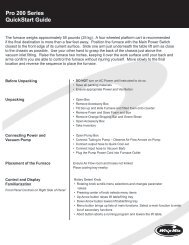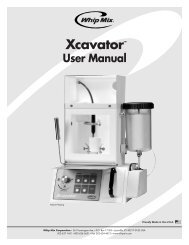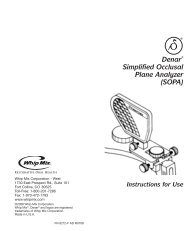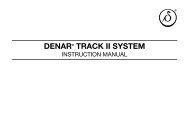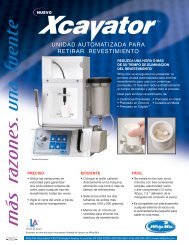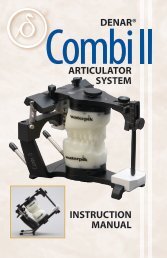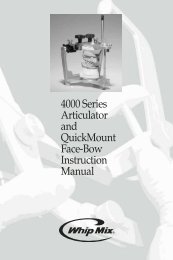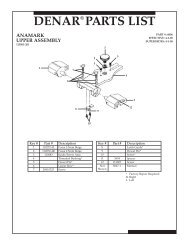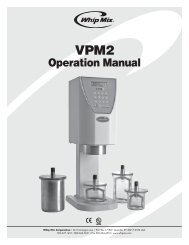Mark II Instruction Manual - Whip Mix
Mark II Instruction Manual - Whip Mix
Mark II Instruction Manual - Whip Mix
You also want an ePaper? Increase the reach of your titles
YUMPU automatically turns print PDFs into web optimized ePapers that Google loves.
An increase of the progressive side shift<br />
movement of the articulator has an effect<br />
of flattening the balancing inclines<br />
of cusps on the orbiting side mediolaterally<br />
(fig. 22).<br />
fig. 19<br />
fig. 20<br />
fig. 21<br />
fig. 22<br />
Three articulator adjustments establish<br />
the character of the orbiting path on the<br />
articulator: the immediate side shift adjustment,<br />
the progressive side shift adjustment<br />
and the protrusive inclination<br />
of the superior fossa wall.<br />
An increase of the immediate side shift<br />
movement of the articulator has an effect<br />
of increasing the bucco-lingual dimension<br />
of the marginal ridge, fossa, or<br />
central groove of the tooth (fig.21).<br />
The closer a cuspal incline is to a condylar<br />
path of movement the greater is<br />
the influence that condylar control has<br />
on occlusal anatomy. Consequently<br />
due to the fact that the orbiting condyle<br />
is moving downward so rapidly as it<br />
moves forward, we observe that as we<br />
move more distally in the dental arches<br />
the lingual cusps of maxillary molars<br />
project increasingly downward and the<br />
buccal cusps of mandibular molars<br />
project increasingly upward to harmonize<br />
the occlusion to condylar paths of<br />
movements (fig 23).<br />
Again by observing a right lateral condylar<br />
movement from the front of the<br />
articulator you can see that the path of<br />
movement of the rotating condyle (rotating<br />
path) as it moves outward is guided<br />
by the rear and top fossa walls (fig.24).<br />
This path of movement is most closely<br />
associated with and has its principle effect<br />
on the working inclines of cusps on<br />
the working side (fig. 20A).<br />
The rotating condylar path may be inclined<br />
upward or downward as the rotating<br />
condyle moves outward. This<br />
upward and downward inclination of<br />
the rotating condylar path in the coronal<br />
plane has its principle influence on the<br />
height of the working inclines of posterior<br />
cusps on the rotating side (fig. 25). If<br />
the rotating condylar path is inclined upward<br />
the cusps must be flatter (fig. 25A).<br />
If the rotating condylar path is inclined<br />
downward the cusps may be steeper<br />
(fig. 25C). The <strong>Mark</strong> <strong>II</strong> Articulator cannot<br />
be adjusted to upward or downward<br />
movements of the rotating condyle.<br />
13





